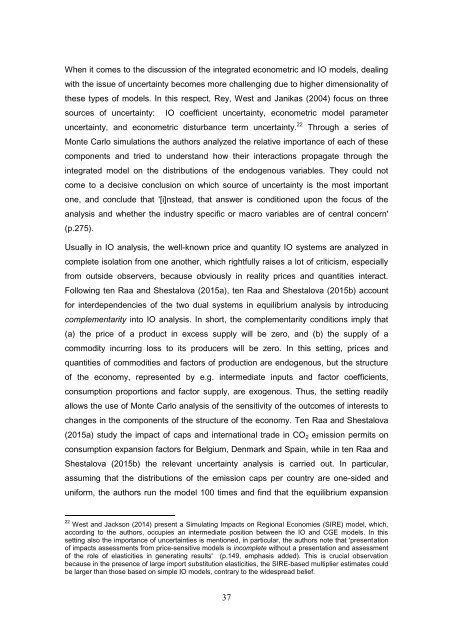Uncertainty treatment in input-output analysis
ifDakU
ifDakU
You also want an ePaper? Increase the reach of your titles
YUMPU automatically turns print PDFs into web optimized ePapers that Google loves.
When it comes to the discussion of the <strong>in</strong>tegrated econometric and IO models, deal<strong>in</strong>g<br />
with the issue of uncerta<strong>in</strong>ty becomes more challeng<strong>in</strong>g due to higher dimensionality of<br />
these types of models. In this respect, Rey, West and Janikas (2004) focus on three<br />
sources of uncerta<strong>in</strong>ty: IO coefficient uncerta<strong>in</strong>ty, econometric model parameter<br />
uncerta<strong>in</strong>ty, and econometric disturbance term uncerta<strong>in</strong>ty. 22 Through a series of<br />
Monte Carlo simulations the authors analyzed the relative importance of each of these<br />
components and tried to understand how their <strong>in</strong>teractions propagate through the<br />
<strong>in</strong>tegrated model on the distributions of the endogenous variables. They could not<br />
come to a decisive conclusion on which source of uncerta<strong>in</strong>ty is the most important<br />
one, and conclude that '[i]nstead, that answer is conditioned upon the focus of the<br />
<strong>analysis</strong> and whether the <strong>in</strong>dustry specific or macro variables are of central concern'<br />
(p.275).<br />
Usually <strong>in</strong> IO <strong>analysis</strong>, the well-known price and quantity IO systems are analyzed <strong>in</strong><br />
complete isolation from one another, which rightfully raises a lot of criticism, especially<br />
from outside observers, because obviously <strong>in</strong> reality prices and quantities <strong>in</strong>teract.<br />
Follow<strong>in</strong>g ten Raa and Shestalova (2015a), ten Raa and Shestalova (2015b) account<br />
for <strong>in</strong>terdependencies of the two dual systems <strong>in</strong> equilibrium <strong>analysis</strong> by <strong>in</strong>troduc<strong>in</strong>g<br />
complementarity <strong>in</strong>to IO <strong>analysis</strong>. In short, the complementarity conditions imply that<br />
(a) the price of a product <strong>in</strong> excess supply will be zero, and (b) the supply of a<br />
commodity <strong>in</strong>curr<strong>in</strong>g loss to its producers will be zero. In this sett<strong>in</strong>g, prices and<br />
quantities of commodities and factors of production are endogenous, but the structure<br />
of the economy, represented by e.g. <strong>in</strong>termediate <strong>in</strong>puts and factor coefficients,<br />
consumption proportions and factor supply, are exogenous. Thus, the sett<strong>in</strong>g readily<br />
allows the use of Monte Carlo <strong>analysis</strong> of the sensitivity of the outcomes of <strong>in</strong>terests to<br />
changes <strong>in</strong> the components of the structure of the economy. Ten Raa and Shestalova<br />
(2015a) study the impact of caps and <strong>in</strong>ternational trade <strong>in</strong> CO 2 emission permits on<br />
consumption expansion factors for Belgium, Denmark and Spa<strong>in</strong>, while <strong>in</strong> ten Raa and<br />
Shestalova (2015b) the relevant uncerta<strong>in</strong>ty <strong>analysis</strong> is carried out. In particular,<br />
assum<strong>in</strong>g that the distributions of the emission caps per country are one-sided and<br />
uniform, the authors run the model 100 times and f<strong>in</strong>d that the equilibrium expansion<br />
22 West and Jackson (2014) present a Simulat<strong>in</strong>g Impacts on Regional Economies (SIRE) model, which,<br />
accord<strong>in</strong>g to the authors, occupies an <strong>in</strong>termediate position between the IO and CGE models. In this<br />
sett<strong>in</strong>g also the importance of uncerta<strong>in</strong>ties is mentioned, <strong>in</strong> particular, the authors note that 'presentation<br />
of impacts assessments from price-sensitive models is <strong>in</strong>complete without a presentation and assessment<br />
of the role of elasticities <strong>in</strong> generat<strong>in</strong>g results' (p.149, emphasis added). This is crucial observation<br />
because <strong>in</strong> the presence of large import substitution elasticities, the SIRE-based multiplier estimates could<br />
be larger than those based on simple IO models, contrary to the widespread belief.<br />
37


